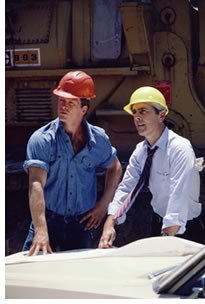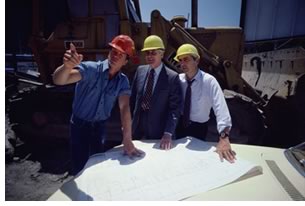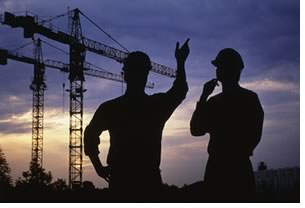

6/2006

by James B. Atkins, FAIA, and Grant A. Simpson, FAIA
One of the more rewarding experiences in architecture is to see your project under construction. Nothing is more exciting than to visit a busy job site, smell freshly cut wood, and observe the trades as they perform their skills and artistry.
The construction phase, as we have noted before, carries a high level of risk. Architects are judged not only by the accuracy of their documents, but also by how quickly they respond and the actions they take. It is understandable that most claims against architects arise during this time.
Site visits should not be approached casually and, above all, should not be eliminated from contracted services. Most states now require that a registered architect be retained to provide construction contract administration services. Many firms have a policy of refusing to eliminate construction contract administration from professional service contracts.
 On the other hand, providing construction services can also bring opportunities.
Should errors or omissions become evident, the architect is available
to provide timely solutions and corrections that can preserve the design
intent and potentially minimize claims for damages.
On the other hand, providing construction services can also bring opportunities.
Should errors or omissions become evident, the architect is available
to provide timely solutions and corrections that can preserve the design
intent and potentially minimize claims for damages.
This article will focus on site visits and on-site activities during the construction phase. It will explore important activities, such as attending and reporting project meetings, reviewing applications for payment, conducting preinstallation conferences, and providing inspections for substantial and final completion. It will address the preparation of field observation reports and some effective ways to communicate the project status to the owner. Visits to the site should be enjoyable, but we should not forget the primary purpose for traveling there.
Preparation
AIA Document G612™-2001, Owner’s Instructions to the Architect
Regarding the Construction Contract, Parts A, B and C, is a useful form
for addressing important issues—such as construction to be performed
by the owner’s own forces, fast track scheduling, phased occupancy,
and bond and insurance information—in addition to information required
for the bidding process. The information on the form should be gathered
from the owner at the start of the project.
The next step in preparation is to read the contracts. The Owner-Architect Agreement contains your service requirements during the construction phase, and the Owner-Contractor Agreement and General Conditions provide information on the contractor’s duties. You should be aware that most of the AIA’s Owner-Architect Agreements incorporate by reference the architect’s construction-phase services described in a particular general conditions document. It is important to determine if the requirements of the Owner-Architect Agreement and the Owner-Contractor contract are consistent. There is a greater likelihood that the documents will be consistent if they are AIA documents. Unfortunately, some owners prefer to use non-AIA documents, or AIA documents that have been extensively modified.
 Variations
in the documents could cause misunderstandings and discord, and you could
be prevented from providing contracted services. For example, if you
have typical basic services during construction in your contract, you
will be required to review and certify contractor applications for payment.
In the event this requirement is not in the contractor’s agreement,
you could be bypassed in the process. Although this may be advantageous
from a risk standpoint, you will not be providing services according
to your contract. Unless the documents can be made consistent though
the change process, you should advise the owner in writing of the discrepancy.
This will document that the owner has been made aware that you will not
be performing the services.
Variations
in the documents could cause misunderstandings and discord, and you could
be prevented from providing contracted services. For example, if you
have typical basic services during construction in your contract, you
will be required to review and certify contractor applications for payment.
In the event this requirement is not in the contractor’s agreement,
you could be bypassed in the process. Although this may be advantageous
from a risk standpoint, you will not be providing services according
to your contract. Unless the documents can be made consistent though
the change process, you should advise the owner in writing of the discrepancy.
This will document that the owner has been made aware that you will not
be performing the services.
When you have determined the contract requirements, you should assemble the necessary items to do your job. These could include:
- Owner-Architect Agreement with atypical conditions noted
- Owner-Contractor Agreement, General Conditions, and Supplementary Conditions with atypical conditions noted
- Drawings and specifications
- Consistent filing protocol for documents
- Laptop computer
- Cell phone
- Blackberry
- Digital camera
- Sketch pad or journal
- Hard hat
- Appropriate shoes
- Safety vest
- Goggles
- Measuring tape
- Flashlight
- Mirror.
Site visits
Site visits can be time consuming and labor intensive, and they should
be planned and executed efficiently. If your contract does not stipulate
a structured sequence or time for visits, discuss with the contractor
during the preconstruction conference which day of the week is best
for the visit. Contractor Work Plans, when the contractor has actually
prepared one, are usually organized around weekly subcontractor meetings,
and team members often prefer the project meeting to be held on the
same day at the same time each week, every two weeks, or at such interval
as agreed upon with the owner.
AIA Document A201™-1997, General Conditions of the Contract for Construction (A201), addresses site visit requirements:
“4.2.2 The Architect . . . will visit the site at intervals appropriate to the stage of the Contractor’s operations (1) to become generally familiar with and to keep the Owner informed about the progress and the quality of the portion of the Work completed, (2) to endeavor to guard the Owner against defects and deficiencies in the Work, and (3) to determine in general if the Work is being performed in a manner indicating that the Work, when fully completed, will be in accordance with the Contract Documents.”
 These three objectives: 1) to report the progress
and quality of the work to the owner, 2) to report any observed deficiencies,
and 3) to assess conformance of completed work to the contract, are
the contracted reasons for visiting the site. The wording, “endeavor to guard,” is
used by claimants in attempts to establish that the architect has a
duty to guard the owner from defects and deficiencies in the work.
This issue is examined in greater detail in a companion article entitled “Sites
Seen and Sights Unseen,” which is scheduled for
publication in AIArchitect later
this year.
These three objectives: 1) to report the progress
and quality of the work to the owner, 2) to report any observed deficiencies,
and 3) to assess conformance of completed work to the contract, are
the contracted reasons for visiting the site. The wording, “endeavor to guard,” is
used by claimants in attempts to establish that the architect has a
duty to guard the owner from defects and deficiencies in the work.
This issue is examined in greater detail in a companion article entitled “Sites
Seen and Sights Unseen,” which is scheduled for
publication in AIArchitect later
this year.
In addition to these contracted services, there are other administrative tasks that can be performed during the visit. Determining the “appropriate” time to visit can be accomplished in several ways. If the contract does not stipulate a specific time or interval, scheduled visits can be determined during the preconstruction conference. The complexity and sequencing of the project may influence the number and frequency of visits. The level of activity may also influence the visit interval. For example, you may visit the site less frequently during excavation and site preparation than during erection of the primary structure. On complex projects, it is important to determine before contract negotiation if a high number of visits will be required.
Structural consultants will conduct their site visits at the beginning of the project, and mechanical, electrical, and plumbing consultants will visit less often in the beginning, with visits increasing as more of their work is installed. Special consultants, such as curtainwall or roofing consultants, will schedule visits as their products or systems are installed. One must always be prepared to go to the site when circumstances demand, but it is more desirable to make scheduled visits and tend to business in an orderly fashion on each occasion.
Site visits are typically scheduled to coincide with the project meeting,
also referred to as the owner-architect-contractor (OAC) meeting. OAC
meetings are often held at the project site to allow reviews of ongoing
construction issues and challenges, presenting an opportunity to “walk
the job” with the owner and contractor.
 Other activities in addition to site observations that are conducted
during site visits include the review of a “pencil copy” of
the contractor payment applications, review of pending change orders,
review of the contractor’s as-built drawings, and, most importantly,
spending time with the owner. Some clients are not familiar with the
construction process and walking the site to review and explain construction
issues and details can put them at ease in addition to cultivating a
relationship.
Other activities in addition to site observations that are conducted
during site visits include the review of a “pencil copy” of
the contractor payment applications, review of pending change orders,
review of the contractor’s as-built drawings, and, most importantly,
spending time with the owner. Some clients are not familiar with the
construction process and walking the site to review and explain construction
issues and details can put them at ease in addition to cultivating a
relationship.
Site observations
Site observations have a limited purpose, and that purpose is misunderstood
by many. A201 requires that we become “generally familiar” with
the work. This is not a requirement to know everything that is going
on. While developing this general familiarity, we are to report deficiencies
if any are observed and determine generally if the completed work conforms
or will conform to the contract requirements. Owners and contractors
frequently want to believe that site observations are thorough inspections
of each element of the project by the architect, but that is simply
not the case. This issue is also addressed in detail in the companion
article scheduled for publication later this year.
For the reason cited above, construction observation carries increased risk and should be undertaken by the most qualified people available for the assignment. Some firms elect to have non-architectural experienced personnel who have knowledge of construction make the site visits. However, this approach can be challenging when design problems arise that require immediate resolution. For this reason, it is desirable to have site visits conducted by the partner, project manager, project architect, or other person who has construction contract administration experience. Larger firms may use a dedicated construction services department to accomplish this task.
 Some
architects prefer to walk the site prior to the OAC meeting to become
familiar with the progress of the work. They may note questionable issues
or conditions that warrant discussion in the meeting. They will also
be able to report the general progress of the work to the owner. When
such opinions about the progress of the work are presented to the owner,
whatever the venue, it is preferable that the architect document the
discussions for their records, even if reported orally. When claims of
negligence are filed against architects, it is often alleged that the
architect was not adequately keeping the owner informed. Good records
of discussions can help defend against this form of amnesia. Many firms
have a policy that a written report is issued after every visit to the
site.
Some
architects prefer to walk the site prior to the OAC meeting to become
familiar with the progress of the work. They may note questionable issues
or conditions that warrant discussion in the meeting. They will also
be able to report the general progress of the work to the owner. When
such opinions about the progress of the work are presented to the owner,
whatever the venue, it is preferable that the architect document the
discussions for their records, even if reported orally. When claims of
negligence are filed against architects, it is often alleged that the
architect was not adequately keeping the owner informed. Good records
of discussions can help defend against this form of amnesia. Many firms
have a policy that a written report is issued after every visit to the
site.
Many owners look forward to the opportunity to walk the site with the architect, and an invitation should be offered accordingly. It is also common in conjunction with the OAC meeting for the contractor to request observations of specific issues and conditions that may require an interpretation by the architect. If the issue cannot be resolved immediately, the architect should be prepared to document the condition for resolution back at the office.
Preparation for walking the site can include a digital camera, a set of drawings for reference, a sketch pad or journal, a measuring tape, and a flashlight. Some architects like to take a mirror for peering into dark or hard to access spaces. If a particular product or system is being observed, it is helpful to have the appropriate shop drawing or product data. Business attire is usually not appropriate if you are walking around formwork and wet paint or entering dusty work areas.
Interaction on the site with the contractor and subcontractors should not be confrontational or argumentative. It can be challenging for the architect to maintain a neutral posture if approached by the contractor or subcontractor on difficult issues. Remember that the overall objective is the same for everyone: to deliver successfully a completed project that conforms to the design concept. Construction administration issues and attitudes are addressed in the October 2005 AIArchitect article, “Zen and the Art of Construction Administration.” (Part I, Part II)
 The contractor is required to provide a safe workplace and give the
architect access to the work. Safety, these days, may involve protective
goggles and a brightly colored safety vest in addition to a hard hat
and appropriate footwear. Some project sites prohibit shorts, as well
as women’s skirts and heels, and require viewing of a safety film
before entering the work area. These precautions are definitely beneficial,
but they are also a testament to the increase in personal injury claims
on projects.
The contractor is required to provide a safe workplace and give the
architect access to the work. Safety, these days, may involve protective
goggles and a brightly colored safety vest in addition to a hard hat
and appropriate footwear. Some project sites prohibit shorts, as well
as women’s skirts and heels, and require viewing of a safety film
before entering the work area. These precautions are definitely beneficial,
but they are also a testament to the increase in personal injury claims
on projects.
Some subcontractors have requested architects to sign a release before entering temporary structures such as scaffolding. AIA documents typically require that the contractor provide a safe workplace and give the architect access to the work. Should you be approached to sign a release, advise the general contractor of the issue and ask how you will be given safe access to the work. The release, while favorably looked upon and possibly initiated by the contractor’s insurance carrier, is contrary to standard AIA contract language.
Concealed and nonconforming work
Observation of the work prior to it being concealed by subsequent work,
if possible within the framework of the project schedule, may require
some level of orchestration. It is advisable to discuss this issue
with the contractor in the preconstruction conference so that site
visits can be planned accordingly. On health-care and other projects
with complex building systems, an “above ceiling punch” is
often done, and timing of the site visit is necessary to coordinate
with available completed spaces. Given the limited nature of the time
the architect spends on site, it may not be possible to review all
work before it is concealed. If you have a special interest in a portion
of the work that may be covered before your next visit, discuss schedule
options with the contractor and/or owner.
In the event work is concealed before the architect has had a chance to make an observation, if the work is suspect, it may be necessary to have the work uncovered. If the observation was discussed in advance, and the contractor concealed work that the architect requested to see without prior notification to the architect, Section 12.1.1 of A201 requires the contractor to uncover the work at his or her own expense if requested to do so.
 When there is no prior understanding that the work is to be left exposed
by the contractor until the observations are made, the contractor can
be required to uncover the work, but if it is found to be acceptable,
the owner may have to pay for the costs involved under A201 Section 12.1.2.
If the work is found to be not in conformance with the contract documents,
the contractor may have to pick up the tab. With the possibility of disputed
costs involved, the decision to uncover concealed work should be discussed
openly and in detail with all involved parties. And, you guessed it,
discussions should be documented thoroughly.
When there is no prior understanding that the work is to be left exposed
by the contractor until the observations are made, the contractor can
be required to uncover the work, but if it is found to be acceptable,
the owner may have to pay for the costs involved under A201 Section 12.1.2.
If the work is found to be not in conformance with the contract documents,
the contractor may have to pick up the tab. With the possibility of disputed
costs involved, the decision to uncover concealed work should be discussed
openly and in detail with all involved parties. And, you guessed it,
discussions should be documented thoroughly.
When nonconforming work is encountered, the contractor should be notified in writing. Although the defects may be discovered with the contractor present, they should nonetheless be documented to allow future confirmation of resolution. Documentation can be accomplished through a field observation report, an OAC meeting report, memorandum, or letter. When you cite nonconforming work and ask that it be remedied, be prepared for resistance, because replacing work already in place is an unpleasant event for everyone. This issue of replacing installed work was addressed in the February 2006 AIArchitect article, “Gimme Shelter.”
Inspections
A201 requires the architect to make only two inspections on each project.
“4.2.9 The Architect will conduct inspections to determine the date or dates of Substantial Completion and the date of final completion . . . ”
These two inspections differ from a scheduled site observation. In the first of these two inspections, the architect is looking at the “completed” work to determine if it appears to be “substantially” complete. Completed work conceals many supporting elements, and there is no way to know if those portions of the project are correctly installed unless the architect witnessed every piece of the project as it was installed. Even though these two events are called “inspections,” it serves to remember that they are based on becoming “generally familiar” with the work and are not based on exhaustive inspections. This complex and often misunderstood event was addressed in an AIArchitect article in January 2006 entitled, “Substantial Completion Where Art Thou?”
 Substantial
completion marks the beginning of the closeout phase of the project,
and adequate preparation will allow for greater efficiency and fewer
misunderstandings as the project comes to an end. A good way to begin
is with a pre-closeout conference. The conference should be attended
by the full project team. Discussions can include level of quality expected,
required closeout documents, the punch list review schedule, and owner-accepted
nonconforming work. Project closeout is addressed in an article entitled
“Effective Project Closeouts‘ in The
Architect’s
Handbook of Professional Practice—2003 Update. The article
will be included in the 14th edition of the Handbook, scheduled
for publication in 2008.
Substantial
completion marks the beginning of the closeout phase of the project,
and adequate preparation will allow for greater efficiency and fewer
misunderstandings as the project comes to an end. A good way to begin
is with a pre-closeout conference. The conference should be attended
by the full project team. Discussions can include level of quality expected,
required closeout documents, the punch list review schedule, and owner-accepted
nonconforming work. Project closeout is addressed in an article entitled
“Effective Project Closeouts‘ in The
Architect’s
Handbook of Professional Practice—2003 Update. The article
will be included in the 14th edition of the Handbook, scheduled
for publication in 2008.
Reporting
The status of construction can be reported in multiple formats. Most
written formats are acceptable as long as they are issued timely. Some
project management software programs include an observation report
form.
AIA Document G711™-1972 Architect’s Field Report (G711), is one of the most common formats for reporting the work progress. The architect usually walks the project—drawings and digital camera in hand—and takes notes or dictates the work that is observed. Images of site conditions can be included in the published report and e-mailed to the recipients. Before images are included, the architect might consider thoroughly examining the image to determine that it is representative of the discussion included in the report and that unreported nonconforming work is not readily visible in the image. Ideally, if nonconforming work is visible in the image, it should be noted in the report.
Other formats can include incorporating reporting of observations into the OAC meeting report or simply sending an e-mail, letter, or memorandum. In any case, it is important to report on the status of the work in accordance with your services agreement.
The contents of the report could include a date and sequential number, notations of work conformance, and general comments of work in progress. G711 contains a distribution check box at the top; however, a mass e-mail transmittal with all project member names and addresses included can save time. The form also has a place for weather, temperature range, and percentage of completion. With the availability of the National Weather Service, and since your contract likely does not require you to assess the percentage of construction completion, you may choose to leave these blank. The same goes for the listing of those present at the site, since those statistics are typically maintained by the project superintendent.
 Your observations on the work status probably should not contain finite
descriptions. For example, if you state that, “the brickwork is
completed,” and it is not completed in every conceivable detail,
you may be accused of misrepresenting the conditions. It is safer to
use phrases such as, “the brickwork appears to be completed.”
Your observations on the work status probably should not contain finite
descriptions. For example, if you state that, “the brickwork is
completed,” and it is not completed in every conceivable detail,
you may be accused of misrepresenting the conditions. It is safer to
use phrases such as, “the brickwork appears to be completed.”
Communication about any subject, particularly about defective or nonconforming work, should include “truths.” While it is true that no one likes to have their work failures aired out for all to see, it is also true that known defective or nonconforming work must be reported and perhaps remedied. For this reason, your comments on defects and deficiencies should be straightforward and declaratory. Comments such as, “repair scratch on door or replace door,” conveys the required actions better than, “the door has a scratch,” or, “the scratch on the door needs to be fixed.” It is a truer statement in the context of the responsibilities of the contractor that the scratch must be repaired than it is that the scratch exists on the door.
Pre-installation conferences
These meetings are held to go over how the contractor and the contractor’s
subs are going to put a specific product or system together or how the
construction of two or more products or systems will affect each other.
Frequently, these meetings cause the contractors to think through what
they are going to do on the project in a way that exposes coordination
or installation difficulties that have not been previously considered.
These meetings also frequently bring about disclosure of substitutions
planned by a subcontractor that may not have been brought to the contractor’s
or architect’s attention. Some examples of the subjects for such
meetings are exterior wall systems and windows, skylights, roofing, waterproofing,
sealants, and other critical and complex assemblies involving coordination
between materials or subcontractors. Attending these meetings with the
owner, contractor, and subcontractors allows a contemporaneous review
of issues related to each system.
 Mock-up reviews
Mock-up reviews
Even very small projects can benefit from a mock-up that tests how a
complicated or critical system will be installed. From simple mock-ups
like tile grout or cabinet doors to complex mock-ups like brick veneer
and metal stud walls, important communication occurs through constructing
and discussing a mock-up. When the mock-up is viewed in the company
of the owner, contractor, and subcontractor, all critical parties have
an opportunity to discuss their expectations for the assembly.
Construction is a team sport
It is exciting to travel to the site and observe your project under construction.
The tedious hours in the design phase seem more worthwhile when you
can see the tangible result. The legacy of an architect is a built
structure for people to see and use and hopefully appreciate and admire.
The construction process today can be risky, and most claims arise from actions or activities that occur during this time. Effective planning, good relationships, and proactive contract administration can reduce risks and make the job a lot easier. As we have emphasized in past articles, the owner will likely remember their experiences during construction much more than the other phases of service. Repeat business can be fostered by an owner’s comfort with your construction contract administration services.
 In positioning for success, the objectives for site visits should ideally
go beyond the three requirements of A201. Spending time with the owner
and discussing the issues of the construction process can be worthwhile
at a time when their money is being spent at a high rate and time pressures
bear. Developing a win-win relationship with the contractors can foster
understanding and assistance when the flaws of human nature manifest
in the work.
In positioning for success, the objectives for site visits should ideally
go beyond the three requirements of A201. Spending time with the owner
and discussing the issues of the construction process can be worthwhile
at a time when their money is being spent at a high rate and time pressures
bear. Developing a win-win relationship with the contractors can foster
understanding and assistance when the flaws of human nature manifest
in the work.
Success with these objectives requires preparation and planning. An effective preconstruction conference and productive project meetings can enable the team to achieve their goals and have more fun in the process.
That phone call just now was the owner, and she wants to you to meet her today at the site to discuss the redesign of the building entrance. Grab your hardhat and journal, and be sure you have some extra pencils. And don’t forget to be careful out there.
Copyright 2006 The American Institute of Architects.
All rights reserved. Home Page ![]()
![]()
This series will continue next month in AIArchitect when the subject will be The Speed of Life, We will examine how advancing technology and compressed work habits have changed the way architectural services are provided. If you would like to ask Jim and Grant a risk or project-management question or request them to address a particular topic, contact the AIA General Counsel Office.
James B. Atkins, FAIA, is a principal with HKS Architects. He serves on the AIA Documents Committee and is the 2006 Chair of the AIA Risk Management Committee. He has been successfully catching javelins for the past twenty-five years.
Grant A. Simpson, FAIA, manages project delivery for RTKL Associates. He is the 2006 Chair of the AIA Practice Management Advisory Group, and he is an accomplished and renowned bullet dodger.
This article represents the opinions of the authors and not necessarily that of The American Institute of Architects. It is intended for general information purposes only and does not constitute legal advice. The reader should consult with legal counsel to determine how laws, suggestions and illustrations apply to specific situations.
![]()